Page 322 of 390
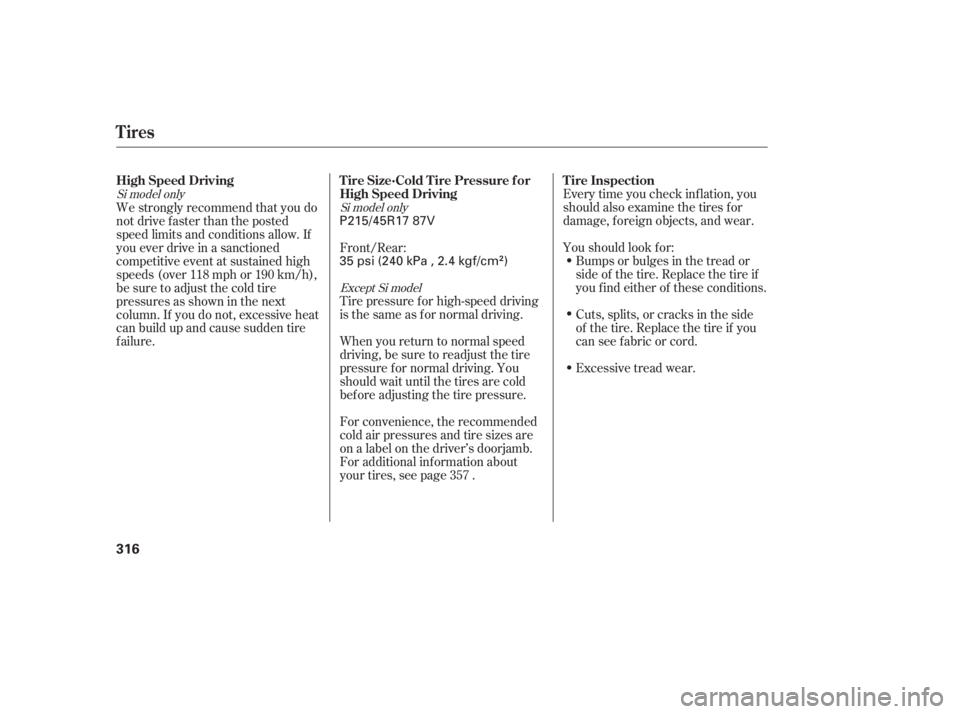
Every time you check inf lation, you
should also examine the tires for
damage, f oreign objects, and wear.
Youshouldlookfor:Bumps or bulges in the tread or
side of the tire. Replace the tire if
youfindeitherof theseconditions.
Cuts, splits, or cracks in the side
of the tire. Replace the tire if you
can see f abric or cord.
Excessive tread wear.
Tire pressure f or high-speed driving
is the same as f or normal driving.
When you return to normal speed
driving, be sure to readjust the tire
pressure f or normal driving. You
should wait until the tires are cold
bef ore adjusting the tire pressure.
For convenience, the recommended
cold air pressures and tire sizes are
on a label on the driver’s doorjamb.
For additional inf ormation about
your tires, see page .
We strongly recommend that you do
not drive faster than the posted
speed limits and conditions allow. If
you ever drive in a sanctioned
competitive event at sustained high
speeds (over 118 mph or 190 km/h),
be sure to adjust the cold tire
pressuresasshowninthenext
column. If you do not, excessive heat
can build up and cause sudden tire
f ailure.
Front/Rear:
357
Si model onlyExcept Si model
Si model only
Tires
Tire Inspection
Tire Size·Cold Tire Pressure f or
High Speed Driving
High Speed Driving
316
P215/45R17 87V
35 psi (240 kPa , 2.4 kgf/cm
)
10/06/23 14:42:33 31SNA650_321
Page 323 of 390
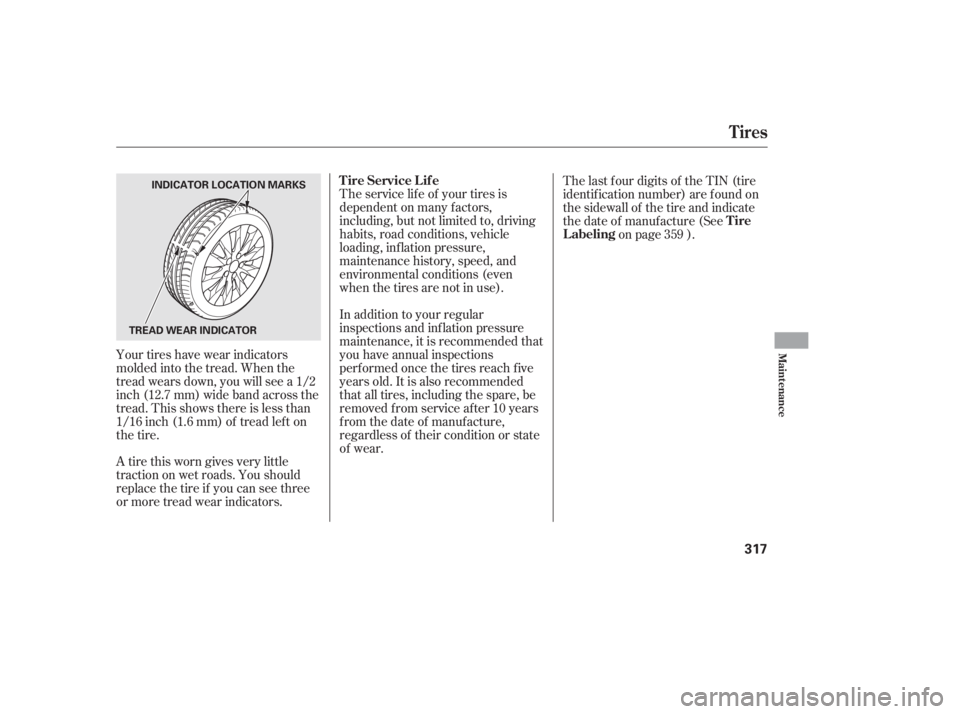
A tire this worn gives very little
traction on wet roads. You should
replace the tire if you can see three
or more tread wear indicators.The service lif e of your tires is
dependent on many f actors,
including, but not limited to, driving
habits, road conditions, vehicle
loading, inf lation pressure,
maintenance history, speed, and
environmental conditions (even
when the tires are not in use).
In addition to your regular
inspections and inf lation pressure
maintenance, it is recommended that
you have annual inspections
perf ormed once the tires reach f ive
years old. It is also recommended
that all tires, including the spare, be
removed from service after 10 years
from the date of manufacture,
regardless of their condition or state
of wear.
The last f our digits of the TIN (tire
identif ication number) are f ound on
the sidewall of the tire and indicate
the date of manufacture (See
on page ).
Your tires have wear indicators
molded into the tread. When the
tread wears down, you will see a 1/2
inch (12.7 mm) wide band across the
tread. This shows there is less than
1/16 inch (1.6 mm) of tread lef t on
the tire. 359
Tires
Tire Service Lif e
Tire
Labeling
Maint enance
317
TREAD WEAR INDICATOR INDICATOR LOCATION MARKS
10/06/23 14:42:42 31SNA650_322
Page 324 of 390
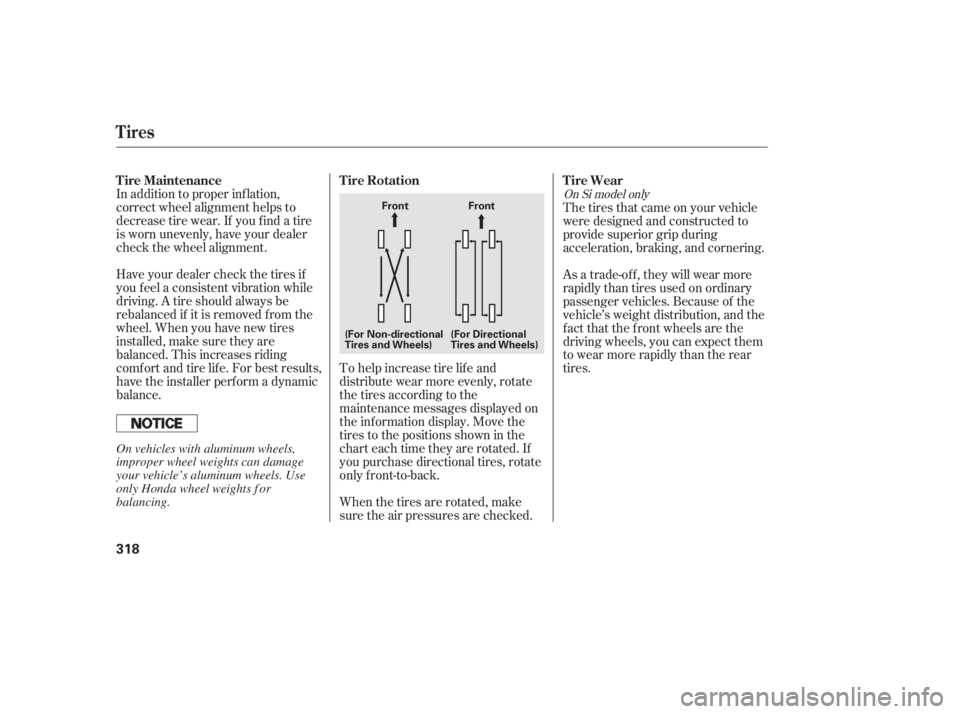
In addition to proper inf lation,
correct wheel alignment helps to
decrease tire wear. If you f ind a tire
is worn unevenly, have your dealer
check the wheel alignment.
Have your dealer check the tires if
you f eel a consistent vibration while
driving. A tire should always be
rebalanced if it is removed f rom the
wheel. When you have new tires
installed, make sure they are
balanced. This increases riding
comf ort and tire lif e. For best results,
have the installer perform a dynamic
balance.To help increase tire lif e and
distribute wear more evenly, rotate
the tires according to the
maintenance messages displayed on
the information display. Move the
tires to the positions shown in the
chart each time they are rotated. If
you purchase directional tires, rotate
only f ront-to-back.
When the tires are rotated, make
sure the air pressures are checked.The tires that came on your vehicle
were designed and constructed to
provide superior grip during
acceleration, braking, and cornering.
As a trade-of f , they will wear more
rapidly than tires used on ordinary
passenger vehicles. Because of the
vehicle’s weight distribution, and the
fact that the front wheels are the
driving wheels, you can expect them
to wear more rapidly than the rear
tires.On Si model only
T ire Maintenance
T ire RotationT ire Wear
Tires
318
FrontFront
(For Non-directional
Tires and Wheels) (For Directional
Tires and Wheels)
On vehicles with aluminum wheels,
improper wheel weights can damage
your vehicle’s aluminum wheels. Use
only Honda wheel weights f or
balancing.
10/06/23 14:42:53 31SNA650_323
Page 325 of 390
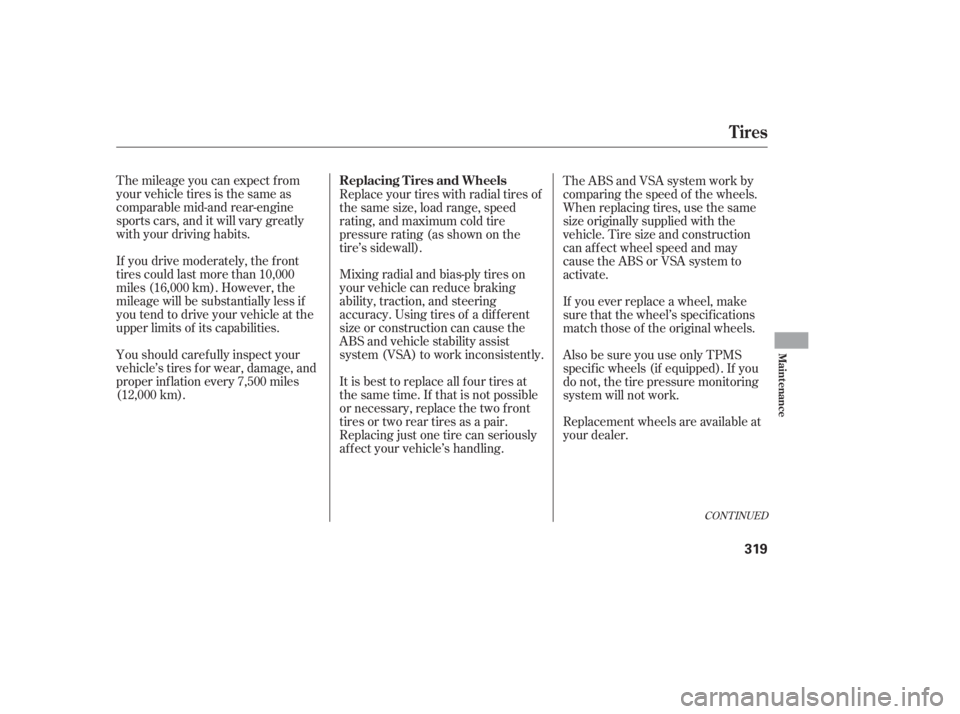
Themileageyoucanexpectfrom
yourvehicletiresisthesameas
comparable mid-and rear-engine
sports cars, and it will vary greatly
with your driving habits.
If you drive moderately, the f ront
tires could last more than 10,000
miles (16,000 km). However, the
mileage will be substantially less if
you tend to drive your vehicle at the
upper limits of its capabilities.
You should caref ully inspect your
vehicle’s tires f or wear, damage, and
proper inf lation every 7,500 miles
(12,000 km).Replace your tires with radial tires of
the same size, load range, speed
rating, and maximum cold tire
pressure rating (as shown on the
tire’s sidewall).
Mixing radial and bias-ply tires on
your vehicle can reduce braking
ability, traction, and steering
accuracy. Using tires of a dif f erent
size or construction can cause the
ABS and vehicle stability assist
system (VSA) to work inconsistently.
It is best to replace all f our tires at
thesametime.If thatisnotpossible
or necessary, replace the two f ront
tires or two rear tires as a pair.
Replacing just one tire can seriously
af f ect your vehicle’s handling.The ABS and VSA system work by
comparing the speed of the wheels.
When replacing tires, use the same
size originally supplied with the
vehicle. Tire size and construction
can af f ect wheel speed and may
cause the ABS or VSA system to
activate.
Replacement wheels are available at
your dealer. If you ever replace a wheel, make
sure that the wheel’s specif ications
match those of the original wheels.
Also be sure you use only TPMS
specif ic wheels (if equipped). If you
do not, the tire pressure monitoring
system will not work.
CONT INUED
Tires
Replacing T ires and Wheels
Maint enance
319
10/06/23 14:43:04 31SNA650_324
Page 333 of 390

This section covers the more
common problems that motorists
experience with their vehicles. It
gives you inf ormation about how to
safely evaluate the problem and what
to do to correct it. If the problem has
stranded you on the side of the road,
you may be able to get going again.
If not, you will also f ind instructions
on getting your vehicle towed.......................
Compact Spare Tire . 328
....................
Changing a Flat Tire . 329
.............
If the Engine Won’t Start . 334
................................
Jump Starting . 336
..............
If the Engine Overheats . 338
.........
Low Oil Pressure Indicator . 340
..........
Charging System Indicator . 340
.......
Malf unction Indicator Lamp . 341
...............
Brake System Indicator . 342
..............................................
Fuses . 343
..............................
Fuse Locations . 347
......................
Emergency Towing . 349
Taking Care of the Unexpected
T aking Care of t he Unexpect ed
327
10/06/23 14:44:12 31SNA650_332
Page 334 of 390
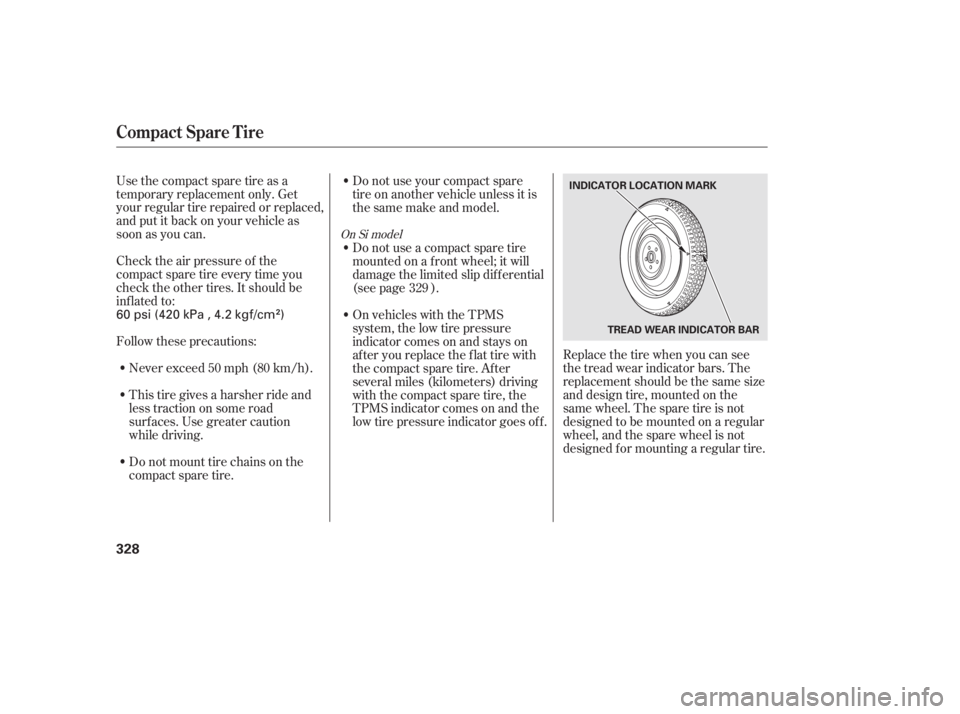
Check the air pressure of the
compact spare tire every time you
check the other tires. It should be
inf lated to: Use the compact spare tire as a
temporary replacement only. Get
your regular tire repaired or replaced,
and put it back on your vehicle as
soon as you can.Replace the tire when you can see
the tread wear indicator bars. The
replacement should be the same size
and design tire, mounted on the
same wheel. The spare tire is not
designed to be mounted on a regular
wheel, and the spare wheel is not
designed f or mounting a regular tire.
Follow these precautions:
This tire gives a harsher ride and
less traction on some road
surf aces. Use greater caution
while driving. Never exceed 50 mph (80 km/h).
Do not mount tire chains on the
compact spare tire. Do not use your compact spare
tire on another vehicle unless it is
thesamemakeandmodel.
On vehicles with the TPMS
system, the low tire pressure
indicator comes on and stays on
after you replace the flat tire with
the compact spare tire. Af ter
several miles (kilometers) driving
with the compact spare tire, the
TPMS indicator comes on and the
low tire pressure indicator goes of f . Do not use a compact spare tire
mounted on a f ront wheel; it will
damage the limited slip dif f erential
(see page ).
329
On Si model
Compact Spare Tire
328
INDICATOR LOCATION MARK
TREAD WEAR INDICATOR BAR
60 psi (420 kPa , 4.2 kgf/cm)
10/06/23 14:44:23 31SNA650_333
Page 339 of 390
Place the flat tire face down in the
spare tire well.
Remove the spacer cone f rom the
wing bolt, turn it over, and put it
back on the bolt.
Securetheflattirebyscrewing
the wing bolt back into its hole.Lower the trunk f loor, and close
the trunk lid.
Store the jack and tools in the tool
case. Place the tool case in the
center of the f lat tire.
Store the wheel cover or center
cap in the trunk. Make sure it does
not get scratched or damaged.
Your vehicle’s original tire has a
tire pressure monitoring system
sensor. To replace a tire, ref er to
(see
page ).
15.
16.
17. 18. 19.
20.
21.
272
CONT INUED
On U.S. models
Changing a Flat Tire
Changing a T ire with T PMS
T aking Care of t he Unexpect ed
333
WING BOLT SPACER
CONE
For normal
tire For spare
tire
Loose items can fly around the
interiorinacrashandcould
seriously injure the occupants.
Store the wheel, jack, and tools
securely before driving.
10/06/23 14:45:12 31SNA650_338
Page 357 of 390
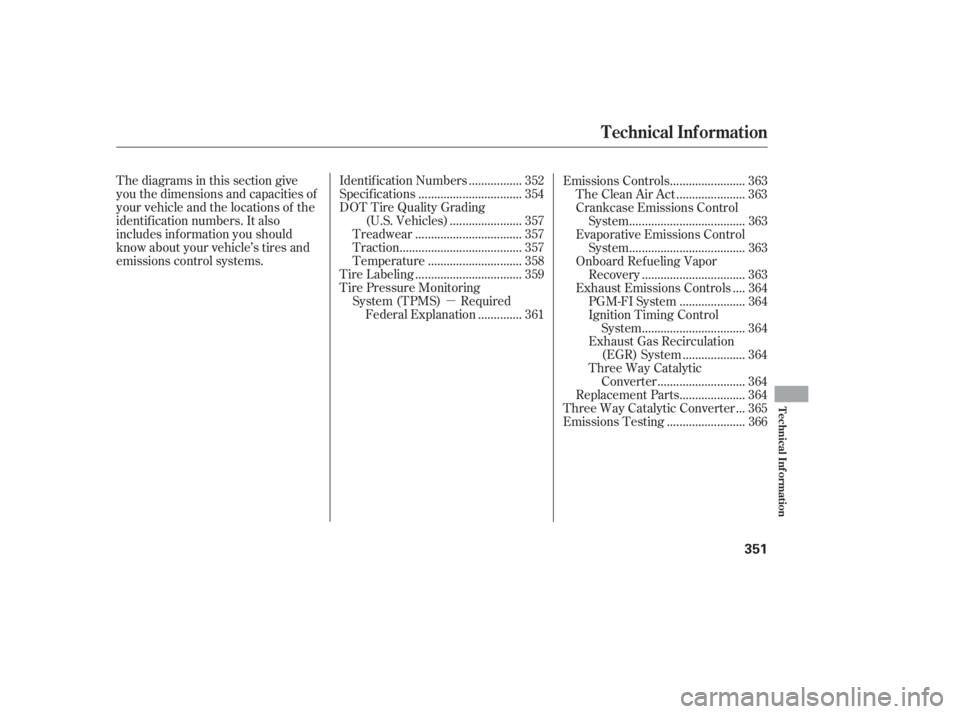
�µ
Thediagramsinthissectiongive
you the dimensions and capacities of
your vehicle and the locations of the
identif ication numbers. It also
includes inf ormation you should
know about your vehicle’s tires and
emissions control systems.
................
Identif ication Numbers . 352
................................
Specif ications . 354
DOT Tire Quality Grading
......................
(U.S. Vehicles) . 357
.................................
Treadwear . 357
......................................
Traction . 357
.............................
Temperature . 358
.................................
Tire Labeling . 359
Tire Pressure Monitoring
System (TPMS) Required .............
Federal Explanation . 361 .......................
Emissions Controls . 363
.....................
The Clean Air Act . 363
Crankcase Emissions Control
....................................
System . 363
Evaporative Emissions Control ....................................
System . 363
Onboard Ref ueling Vapor ................................
Recovery . 363
...
Exhaust Emissions Controls . 364
....................
PGM-FI System . 364
Ignition Timing Control
................................
System . 364
Exhaust Gas Recirculation ...................
(EGR) System . 364
Three Way Catalytic ...........................
Converter . 364
....................
Replacement Parts . 364
..
Three Way Catalytic Converter . 365
........................
Emissions Testing . 366
T echnical Inf ormation
Technical Inf ormation
351
10/06/23 14:47:57 31SNA650_356